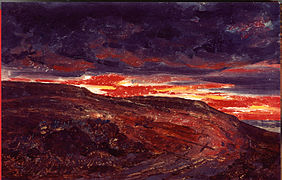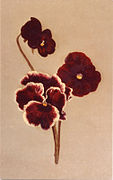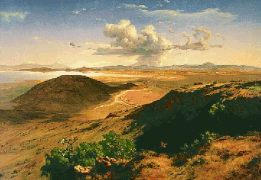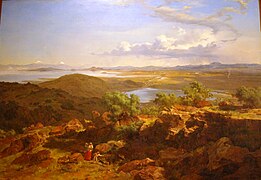Jose Maria Velasco Gomez Obregon
José María Velasco y Gómez-Obregón (Temascalcingo, Department of Mexico, July 6, 1840 - Villa de Guadalupe Hidalgo, Mexico City, August 26, 1912) was a Mexican landscape painter.
Childhood
José María Velasco was born on July 6, 1840 in Temascalcingo, State of Mexico. According to his baptismal certificate, he received the names José María Tranquilino Francisco de Jesús Velasco y Gómez-Obregón.He was the first of five children born to Don Felipe Velasco and Doña María Antonia Gómez-Obregón de Velasco. In 1849, his family moved to Mexico City, where Don Felipe, father of José María, died five months later, victim of an epidemic of morbid cholera that struck the city in 1850.
After the death of his father, José María worked as a clerk in a clothing store while he studied at the Lancasterian College of Santa Catarina Mártir. It was there that he began to feel a great love for drawing and show his remarkable skills. At the same time that he was selling rebozos, he attended night classes at the Academy of San Carlos School of Fine Arts, where he was a student of the Italian Eugenio Landesio, who guided him down the path of realism and landscape art.
In 1858, at the age of 18, he was awarded a professorship at the Academia de San Carlos in Perspective, thanks to his studies. He continued his studies in anatomy, zoology, geography and architecture, key knowledge to capture a refined technique in his realistic paintings, creating a very identifiable style. & # 34; It was that visual sense, his sensitivity and his knowledge that gave the landscapes a personality of his own & # 34;.
Early years in San Carlos
In 1855, José María Velasco completed his primary studies and, thanks to Mr. Luis Ponce de León, he entered the Royal Academy of Fine Arts of San Carlos de México that same year to study at night what he was most passionate about. For three months, Velasco drew in the corridors of the Academy under the direction of Mr. Miguel Mata, until, together with the sculptor Felipe Sojo, he had the opportunity to receive classes from Mr. Juan Urruchi. A few months later, he entered the landscape class taught by the famous Italian painter Don Eugenio Landesio, originally from Turin, who came to Mexico at the initiative of the director of the academy, the Spanish painter Pelegrín Clavé, since Landesio, having been a disciple of Carlos Markó, mastered the landscape technique. Landesio spoke a lot to his students about the rules of composition, he commented on his studies and works, those of Markó, and he made them notice all the beauties he found in his path, paying attention to the details of light, color and shape.. On the other hand, since Velasco began in the corridors of the Academy with his first essays, he also undertook the study of the sciences that he considered suitable for his future profession.
Velasco took Anatomy classes taught by Dr. Manuel Carpio, studied Geology at the Palacio de Minería and also took classes in Botany, Zoology, Mathematics and Physics.
The scarcity of financial resources led him to doubt whether he should continue his studies. However, in 1860, the painter Santiago Rebull arrived in Mexico from Europe to take up the position of general director of the San Carlos Royal Academy of Fine Arts. That year, Landesio and Rebull organized a contest whose prize would be a pension for the winner. Velasco won the prize with his work on the former convent of San Agustín. This triumph, in addition to solving his financial problems, filled him with confidence and enthusiasm, and prompted him to dedicate himself more zealously to his career, launching into the countryside with the aim of painting from life.
At the time that José María Velasco entered the Academy of San Carlos, the predominant theme of Mexican painters was the human figure in its different variants: religious, mythological, historical compositions, etc. The fact that Velasco dedicated most of his works to the representation of nature positions him as an innovator in painting and the ecology of his time. His visual sense, his sensitivity and his knowledge allowed him to perceive beyond what a normally gifted person can observe in terms of the shape, colors and characteristics of the landscape. When Velasco formally began his studies, his work was largely influenced by Landesio's technique. However, Velasco soon began to perceive the landscape of Mexico with his own Mexican eyes, little by little moving away from the academic characteristics of the art that was practiced in the second half of the 19th century. With his own well-formed personality, he managed to create masterpieces that earned him recognition both in America and in Europe. It is quoted: "The painting of José María Velasco can be a good way to understand these kaleidoscopic ideas. It is obvious that the landscape of the Valley of Mexico painted by him after his diaphanous presence contains a complex construction, an engineering of aerial perspectives, lines, proportions, volumes and colors that is difficult to conceive or find before Velasco, no matter how there have been diverse and noble precedents, such as the artists Rugendas, Nebel or the painters of the early 19th century." Velasco was a pioneer in the representation of nature and the Mexican landscape in his works, which allowed him to open new paths in painting and the ecology of his time. His artistic legacy continues to be appreciated and studied today, both in Mexico and abroad.
Professional and family life
In 1868, Velasco was appointed Professor of Perspective and it was then that he resigned from the pension he was enjoying. In this same year he married Miss Luz Sánchez Armas Galindo, his brother Dr. Ildefonso Velasco and his teacher Eugenio Landesio being his wedding witnesses, which shows the friendship that already existed between these two strongly identified landscapers..
As a result of their marriage, their daughter Mercedes Velasco Sánchez Armas was born, whose descendants paid tribute to the painter in 2007.
In the year 1888, he had the honor of being commissioned by the Government of Mexico as head of the delegation that would attend France carrying paintings by various authors, to be exhibited at the Universal Exposition in Paris, which commemorated the first centenary of the French Revolution. There were 68 works that were presented by Velasco on that occasion.
In his correspondence at that time he expressed:
"... my paintings have produced a lot of effect, they like a lot and have been surprised to see that in Mexico they can paint these works that judge of quite merit [...] my paintings have liked, all praise and draw attention to them. [...] Yesterday I received the Knight of the Legion of Honor, it is a reward that honors me very much and I consider it a great distinction. I am very happy to have received this award that rewards me with the great sacrifice of having separated me from my family..."
In 1893, he attended the World's Columbian Exposition in Chicago, the exhibition that celebrated the fourth centenary of the discovery of America.
Last years
During this period, José María Velasco suffered a heart attack. Despite the illness, he continued to paint with determination. In 1902, he stopped teaching Perspective at the Academia de San Carlos. As of 1905, although his artistic production continued to be abundant, he dedicated himself to painting almost exclusively in his house in the Villa de Guadalupe Hidalgo. Velasco died on August 26, 1912 and was buried in the Tepeyac pantheon.
Tributes
In 1962, in Mexico City, the José Clemente Orozco Gallery changed its name to José María Velasco Gallery in honor of the artist.
On July 6, 2012, in commemoration of the 172nd anniversary of the birth of José María Velasco, the Google search engine dedicated a doodle to him.
In commemoration of his 172nd birth anniversary from July 15 to August 12, 2012, there was a national summer promotion to visit museums in honor of him.
There is a station on line 1 of the Mexico City Metrobús called "José María Velasco". The icon of said station is a mountain, making reference to the landscape art of Velasco.
Gallery
Additional bibliography
- Ovando, Claudia (1998). José María Velasco (2 edition). Instituto Nacional de Estudios Históricos de la Revolución Mexicana. ISBN 9706283277.
- Altamirano Piolle, María Elena (2006). José María Velasco: Landscapes of light, horizons of modernity. Editorial Equilibrista. ISBN 9685011613
Contenido relacionado
Vera Alentova
National Conservatory of Music (Argentina)
The Luthiers














